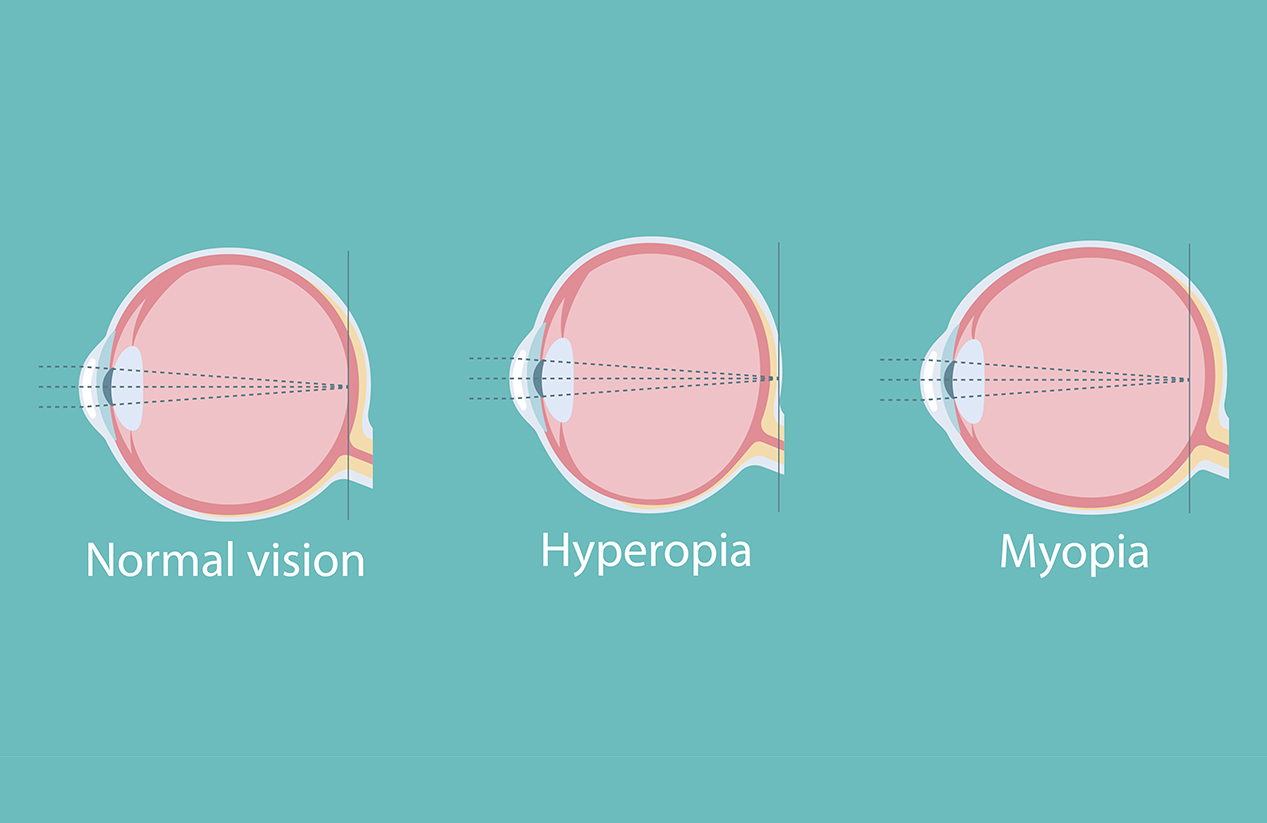- Eyeglasses
- Glasses
- Shop By Frame
- Shop By Style
- Featured
- Premium Selection
- Sunglasses
- Kids' Glasses
- Readers
- Shop By Lens
- Promium Selection
- Accessories
- My Orders
- Order Tracking
- Blog
- Have a Question?
- E-mail:cs@efeglasses.com

Your eyes burn again, don’t they? You blink hard, rub them, then hold your phone a little farther away. Suddenly the words blur. The screen feels bright and fuzzy. But you can still see the TV clearly — weird, right? That’s exactly how farsightedness (hyperopia) sneaks up on you. One moment you’re fine, and the next you’re squinting at a text message.
This guide breaks down what farsighted means, why that little “+” sign shows up on your glasses prescription, and how the right lenses — like those from EFE Glasses — can make your vision feel sharper and more comfortable again.
What Is Farsightedness (Hyperopia)?
Farsightedness means you can see faraway objects clearly, but things up close — books, menus, phone screens — look blurry or out of focus.
Here’s what’s happening: when light enters your eyes, it focuses behind your retina instead of directly on it. So nearby objects look unclear.
This usually happens because:
Your eyeball is shorter than normal from front to back, or
Your cornea is too flat, so the light bends too weakly.
Your eyes then work extra hard to focus, which leads to eye strain, headaches, and fatigue — especially after reading or long screen sessions.

The Physical Cause of Farsighted Vision
Think of your eyes like a camera. When the lens is slightly off, the image won’t land where it should.
If the eyeball is short, the focal point falls behind the retina.
If the cornea is flat, the light bends less and never quite meets the right spot.
Both conditions create the same effect: you struggle with near vision, and your eyes constantly refocus — which is why you end up tired or sore by the end of the day.
Common Symptoms of Hyperopia
Farsightedness isn’t just blurry vision. It’s the constant effort your eyes put in to stay focused.
Typical signs include:
Blurry vision when reading or using your phone
Sore, burning, or tired eyes
Headaches after long focus sessions
Squinting to see clearly
If these sound familiar, it’s time to get an eye exam. EFE Glasses recommends regular checkups — even minor hyperopia can cause strain if left uncorrected.
Reading Your Prescription: What the “+” Means
That plus (+) sign on your prescription tells you that you’re farsighted.
It means your eyes need convex (plus) lenses — lenses that bring light rays inward so they meet perfectly on your retina.

Understanding Diopter Strength
Lens power is measured in Diopters (D). The higher the number, the stronger the correction.
| Diopter (D) | Vision Impact | Notes |
|---|---|---|
| +0.25 D | Mild hyperopia | Mostly noticeable when reading |
| +1.75 D | Moderate | Likely need reading or all-day glasses |
| +3.00 D+ | Strong | Requires higher-power lenses |
A higher prescription isn’t bad news — it just helps your optometrist create lenses that suit your exact visual needs.
Hyperopia vs. Myopia vs. Astigmatism
People often confuse these three, but here’s a simple breakdown:
Hyperopia (Farsightedness): Light focuses behind the retina → close objects blurry → needs plus (+) lenses.
Myopia (Nearsightedness): Light focuses in front of the retina → far objects blurry → needs minus (–) lenses.
Astigmatism: Light focuses unevenly → both near and far look distorted → corrected with cylinder (CYL) power.
Understanding these helps you read your glasses prescription better — and discuss lens options confidently when shopping at EFE Glasses.

Hyperopia Through the Ages
Farsightedness doesn’t affect everyone the same way. It changes with age and eye flexibility.\
Latent Hyperopia – The Hidden Strain in Young Eyes
Younger people can often “hide” hyperopia because their eyes automatically adjust (a process called accommodation). But that constant adjustment leads to eye fatigue, headaches, and blurry spells — especially after screen time.
Hyperopia & Presbyopia (Age-Related Farsightedness)
After your 40s, your eye’s natural lens becomes less flexible. This is presbyopia. It often combines with hyperopia, making close-up vision even tougher. That’s when you start holding menus out at arm’s length or needing brighter light to read.
Hyperopia in Children
In kids, untreated hyperopia can disrupt visual development. It may cause lazy eye (amblyopia) or crossed eyes (strabismus). That’s why regular eye exams for children are crucial — early detection can prevent long-term vision issues.
Correcting Farsightedness: The Lens Solutions
The good news? Farsightedness is easily corrected.
Convex lenses (also called “plus lenses”) bend incoming light so it focuses directly on the retina — restoring clear, relaxed vision.
Choosing the Right Lens Type
Single-Vision Lenses: Great for mild hyperopia or if you only need help for reading or computer work.
Progressive Lenses: Perfect for people over 40 or anyone needing both near and far correction — seamless focus at all distances.
For Stronger Prescriptions (+3.00 D or higher)
High prescriptions can make lenses thicker. But modern high-index lenses (1.67 or 1.74) solve this — thinner, lighter, and more flattering. EFE Glasses offers premium high-index options so your style never has to compromise for clarity.

Extra Lens Features for Comfort
To enhance visual comfort and eye protection, look for:
Anti-reflective coating – reduces glare from screens and headlights
Blue light filter – protects against digital eye strain
UV protection – guards your eyes from harmful sun rays
These upgrades are available across EFE Glasses’ lens collections — blending comfort, clarity, and style.
Myth Buster: Do Glasses Make Your Eyes Weaker?
Nope — that’s a myth. Wearing glasses doesn’t weaken your eyes; it actually reduces strain and lets your vision system relax. The right prescription simply helps your eyes work efficiently.
Conclusion: Sharpen Your World with the Right Lenses
Farsightedness (hyperopia) simply means your eyes focus light a bit behind where it should. It’s not dangerous — just a sign you need the right lenses to bring things back into focus.
With properly fitted plus-power lenses from EFE Glasses, reading feels effortless, screens stop burning, and headaches fade away.
So, if near vision has been bothering you, get your eyes checked and find your next pair of EFE Glasses — where comfort, precision, and style meet in perfect focus.
SUBSCRIBE & SAVE
- Shop All
- Best Sellers
- Eyeglasses
- Sunglasses
- Reading Glasses
- Shop By Frame
- Shop By Style
- Glasses Colors
- Black Glasses
- Blue Glasses
- Brown Glasses
- Gold Glasses
- Green Glasses
- Orange Glasses
- Pink Glasses
- Red Glasses
- Yellow Glasses
- Silver Glasses
- White Glasses
- Purple Glasses
- Tortoiseshell Glasses
- Clear Glasses
- Transparent Grey Glasses
- Mens Blue Glasses Frames
- Red Sunglasses
- Rose Gold Glasses
- White Frame Sunglasses
- Black And Clear Eyeglass Frames
- Black And Gold Glasses
- Black And Red Glasses
- Black Glasses For Women
- Black Rectangle Glasses
- Black Rectangle Sunglasses
- Blue Light & Blocking Glasses
- Blue Women Eyeglasses
- Tips & Guides
- About EFE
- Shop



















